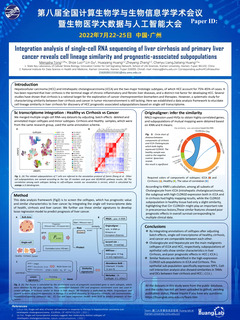Integration analysis of single-cell RNA sequencing of liver cirrhosis and hepatocellular carcinoma reveals cell lineage diversity and prognostic-associated subpopulations
编号:70
稿件编号:28 访问权限:仅限参会人
更新:2022-07-07 16:35:48
浏览:1289次
张贴报告

摘要
Liver cancer, one of the most lethal malignancy in the world, exhibits etiological and biological diversities. Hepatocellular carcinoma (HCC) and intrahepatic cholangiocarcinoma (ICC) are the two major histologic subtypes, of which HCC account for 75%–85% of cases. It has been reported that liver cirrhosis is the terminal stage of chronic inflammatory and fibrotic liver diseases, and a distinct risk factor for developing HCC. Several studies have shown that cirrhosis is a rational target for the exploration of cancer chemoprevention biomarkers and therapies. However, a systematic study for characterizing similarity between liver cirrhosis and cancer in tumor microenvironment is still lacking. Here we established a data analysis framework to elucidate cell lineage diversity in liver cirrhosis for HCC prognostic-associated subpopulations discover. Firstly, we integrated the single-cell RNA sequencing datasets of liver cirrhosis (GSE136103) and HCC (GSE125449). The merged dataset includes 65,353 cells, which were clustered and annotated into 13 cell subtypes. Then, we constructed k-Nearest Neighbors graph network, and measured the similarity between cell clusters by calculating the community connectivity. We found a sub group of tumor Cholangiocyte cells were similar to cirrhotic Cho XIST+ cells. The common marker genes of tumor Cholangiocyte cells and cirrhotic Cholangiocyte cells were associated with SPP1 pathway, which indicates that this Cholangiocyte cells play an important role in HCC development and tumor immunity. Then, we collected five independent bulk transcriptome datasets with survival time including 1,021 patients. Using univariate Cox regression, we obtained genes whose expressions were significantly correlated with the overall survival time for patients in each bulk dataset. For each cell type, these Cox associated genes were used to performed single sample gene set enrichment analysis (ssGSEA) to explore the degrees of different survival outcome. We found several cell types shown strong prognostic values. Unfavorable prognostic subpopulations included Cholangiocyte, Hepatocyte and Mesenchyme cells. Favorable prognostic subpopulations included Mononuclear phagocytes cells. Finally, we explored cell-cell interactions between cancer cells and tumor microenvironment. We highlighted several cell groups with strong cell-cell interaction signals including CXXL12/CXCR4. We found some novel interactions in the signal pathways such as SPP1, complement and collagen signaling. These results demonstrate that the integration analysis of liver cirrhosis and HCC single cell transcriptome to enable precision cancer prognosis.
发表评论